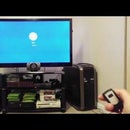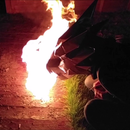Introduction: RGB Aquarium Lights With Sunsets and Sunrises
Replacing florescent tubes (T8) with RGB LED lights, so gently fade between day time and night time via a sunrise, and sunset approximation.
My fish visibly freak out when the timer turns the fluorescent tubes off, or when they flicker on.
Unfortunately, Fluorescent tubes can't be dimmed either, which means I can't have them gently fade on or off.
LED replacement tubes are expensive, and could be dimmed. but getting them to gradually turn on or off on a timer isn't a product I could find. LED tubes also don't put out as many lumens as fluorescent tubes.
My Axolotl doesn't seem to be able to catch fish in the day time, but has a feast at night. So I want a night light to give the other fish a chance. I tried one off eBay, it was too bright.
What I want is; very low intensity lights at night. fading gently into bright light in the day time, then back out in the evening. To achieve this I plan to use RGB LED strips, an Arduino to control the light hue and intensity, and a RTC (Real time clock) to make the transitions happen at the right times.
Step 1: The Plan
Waterproofing is hard. So I want to use what I've got, and has been working so far. The plan is to replace the fluorescent tubes, with my custom equivalent. To do this I will need:
- Plastic tube of the same OD (26mm) as the fluorescent tube.
- Aluminium tube (16mm OD) to wrap the LED's around, as a heat sink, and former.
- 5050, 60 LED/m, RGB, 1-1.2A per meter. 12V, 4.5m needed per 900mm tube.
- Need Arduino to do PWM the RGB LEDs
- Need RTC so Arduino knows what time it is
- Need a power amp, because the Arduino can't put out enough currant to drive the LED's
- Need a >130W PSU to power it.
I bought two 5m kits off amazon because it was cheaper than buying PSU's separately. The two laptop style PSU's were 2-2.5A rather than 5A the website toted them to be, or that the labels on them suggested. So the lights weren't that bright, one PSU died within 10 hours, and the other isn't up to the job. My advice; avoid buying bundled PSU's, they probably won't be up to the task. And make sure the PSU you buy, is well over spec'd to ensure it's not put under too much strain.
Also, at full whack, my 9m of RGB is pulling 65.5w. That's only about 6 Amps. So my 20 amp PSU is too far over spec.
Step 2: Getting the Lights Ready
- First I ripped out the wiring from the fluorescent system.
- Then I cut down the plastic and aluminium tube to fit. Same length as the original tube will work once the connectors are gutted.
- The tubes need the edges chamfering it so that it doesn't catch any LEDs or seal
- Check the LED strips are fully working, no dead pixels
- Wrap the strip around the aluminium tube at a tight angle. Like a helix.it should touch itself edge to edge on the next layer.
- Slide the led wrapped aluminium tube into the plastic tube.
- You will have to drill out your connectors to make enough room for the ribbon to get through into the hood.
- screw it all up
- clip it back together
- give it another test
Step 3: Arduino Wiring and Programming
There is a photo of the wiring.
I've attached the program for you.
It's a bit counter intuitive because the LED's are common Anode (+ve 12v). So it works by grounding the pin. 255 is 12v, so the potential difference is 0v between it and the 12v common anode. So in this situation they're off. 0 PWM is 0v, 0v to 12v, is 12v potential difference, so 0 PWM is 100% on.
It changes by 1 of 255 per second on each channel, Red, Green, and Blue.
When the Arduino turns on, all the outputs go to 0. So the grounded pins make the lights come on full whack for a moment. But it quickly initialises and sets the lights to the correct level.
I've programmed it to start from night mode, sequentially until it catches up with the cycle it should be in. This will take 13 minutes maximum.
Attachments
Step 4: Results
The lights are plenty bright enough, but not as bright as I expected. I ended up turning the blue down a bit so that it gave a "warmer", more daylight like light.
It transitions between modes so gently, you often don't notice it's happening. The fish seem much happier. I have a reclusive Pleco, and she never used to come out when you were in the room, now she comes out as soon as it's in night mode. Sometimes twilight and daylight too.
You can end up with some strange intermediate hues as it transitions. This is because the Red, Green, and Blue, channels are changed by 1 unit per second. Not proportionally. This could be fixed with a little coding to limit the difference between each variable during a transition, or to change the values proportionally, which would avoid the occasional odd colour tinge.
- Would I do it again?
- Yes
- Would I recommend it to others?
- For ease of use, yes.
- For serious fish keepers who care about the intensity and wave length of light for plant health: possibly not.
- Having said this, my plants are doing fine. Possibly better than with the old lights!












